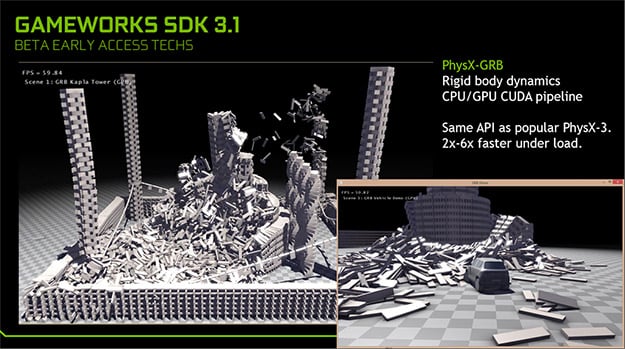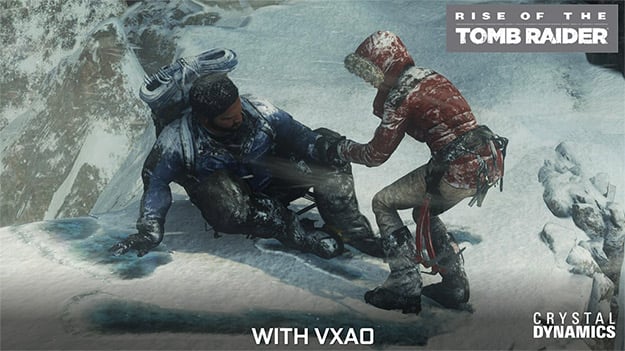NVIDIA GameWorks SDK Update: High-Quality Shadow & Lighting Techniques, PhysX Enhancements
Although the names, or more specifically the acronyms, for some of the new technologies NVIDIA is unveiling today leaked out recently, details on what they offered gamers and how they worked were scarce. At the Game Developers Conference currently underway in San Francisco, however, NVIDIA officially took the wraps of some new graphics techniques for shadows and lighting – dubbed Hybrid Frustum Traced Shadows (HFTS), NVIDIA Volumetric Lighting, and Voxel Accelerated Ambient Occlusion (VXAO) – which can drastically improve in-game image quality. And the features are already being leverages in a trio of popular games, thanks to some recent updates and patches.
Earlier in the week, NVIDIA also announced availability of its latest NVIDIA GameWorks software development kit (SDK), which is now up to version 3.1. In addition to the aforementioned new lighting and shadowing techniques, the latest GameWorks SDK also offers a couple of beta updates to PhysX. One is PhysX-GRB which a new implementation of NVIDIA’s popular PhysX rigid body dynamics SDK. PhysX-GRB uses a hybrid CPU/GPU physics pipeline to potentially improve performance by up to 6x versus the previous version, for moderate to heavy simulation loads.
Also in the SDK is something called NVIDIA Flow. Flow can be considered a new generation of NVIDIA’s Flame Works technology that we first showed you here. Flow is a computational fluid dynamics algorithm that realistically simulates and renders combustible fluids, like fire and smoke. Whereas previous methods for rendering combustible fluids were limited to the constraints of a bounding box in a game world, NVIDIA Flow is not. The effects look great when animated and easily create some of the most realistic looking animated flames / smoke we have seen to date.
PhysX-GRB and Flow will need to be adopted by game developers before they become a reality in any games, but the new Volumetric Lighting, Hybrid Frustum Traced Shadows (HFTS), and Voxel Accelerated Ambient Occlusion (VXAO) techniques are actually available to try right now with the latest patches for Fallout 4 (volumetric lighting), Tom Clancy’s The Division (HFTS), and Rise of the Tomb Raider (VXAO).
Bethesda, the developers of Fallout 4, turned to NVIDIA to incorporate Volumetric Lighting, or “God Rays” into the game. The technique that NVIDIA is introducing uses a physically-based light scattering algorithm that simulates and atmosphere of micro-particles that reflect and refract light. Light volume geometry is extruded from the directional light map, and then the light is scattered along the line of site and integrated to the scene.
The latest patch for Rise Of The Tomb Raider makes use of NVIDIA’s Voxel Accelerated Ambient Occlusion. NVIDIA is calling VXAO the “highest quality Ambient Occlusion solution available for PC games” and from what we’ve seen NVIDIA ain’t kidding. VXAO differs from solutions like SSAO, which is a Screen-Space Ambient Occlusion solution in that VXAO uses a world-space algorithm. The end result is superior image quality, which preserves finer details and has greater overall accuracy, and smoother response to motion. We should also mention that VXAO is available for both DirectX 11 and 12 implementations.
The latest patch for Rise Of The Tomb Raider makes use of NVIDIA’s Voxel Accelerated Ambient Occlusion. NVIDIA is calling VXAO the “highest quality Ambient Occlusion solution available for PC games” and from what we’ve seen NVIDIA ain’t kidding. VXAO differs from solutions like SSAO, which is a Screen-Space Ambient Occlusion solution in that VXAO uses a world-space algorithm. The end result is superior image quality, which preserves finer details and has greater overall accuracy, and smoother response to motion. We should also mention that VXAO is available for both DirectX 11 and 12 implementations.
VXAO uses lighting data from the world space in addition to something NVIDIA calls opacity voxels, to better determine which parts of the geometry in a scene are lighted or in shadow. If you look at the differences in the tank and debris in NVIDIA’s demo, the quality difference is stark. Inspect the space beneath the tank in particular and lighting / shadowing quality of the ground and tracks in the VXAO example is clearly superior. There is a performance penalty associated with using VXAO, however, so it’s meant for high-end GPUs.
If you look at the characters in Tomb Raider, and focus your attention to the areas around the left side of their bodies and under the guy’s arm, the differences in the scene are readily apparent. Depending on the complexity and lighting of the scene, the effects can be subtle, but the end results appear more realistic on-screen.
Tom Clancy’s The Division makes use of NVIDIA’s new Hybrid Frustum Traced Shadows. HFTS is an algorithm for drawing high-quality, more realistic shadows that smoothly transition from hard shadows near the occluding object, to proper soft shadows in regions farther away.
In the screenshot from The Division (annotated by NVIDIA) the shadow is detached from the object on the ground, which is an unwanted artifact that can occur with some shadowing techniques, like shadow maps. The shadow edges furthest from the tree’s branches are too hard, and the shadow edges cast from the milk crate are too soft. When using HFTS, however, all of those issues are resolved and the shadows look far more realistic.
In the screenshot from The Division (annotated by NVIDIA) the shadow is detached from the object on the ground, which is an unwanted artifact that can occur with some shadowing techniques, like shadow maps. The shadow edges furthest from the tree’s branches are too hard, and the shadow edges cast from the milk crate are too soft. When using HFTS, however, all of those issues are resolved and the shadows look far more realistic.
NVIDIA HFTS works by using the geometry shader to construct four planes for each light-space primitive, and then the pixel shader test multiple points along the frustum to ascertain the screen pixels mapped to a given light space texel. The technique uses a hybrid approach to generate the shadows where frustum traced shadows are prevalent the closer you get to an object blocking light and percentage-clear soft shadows (PCSS) are used at points farther away from the object.












